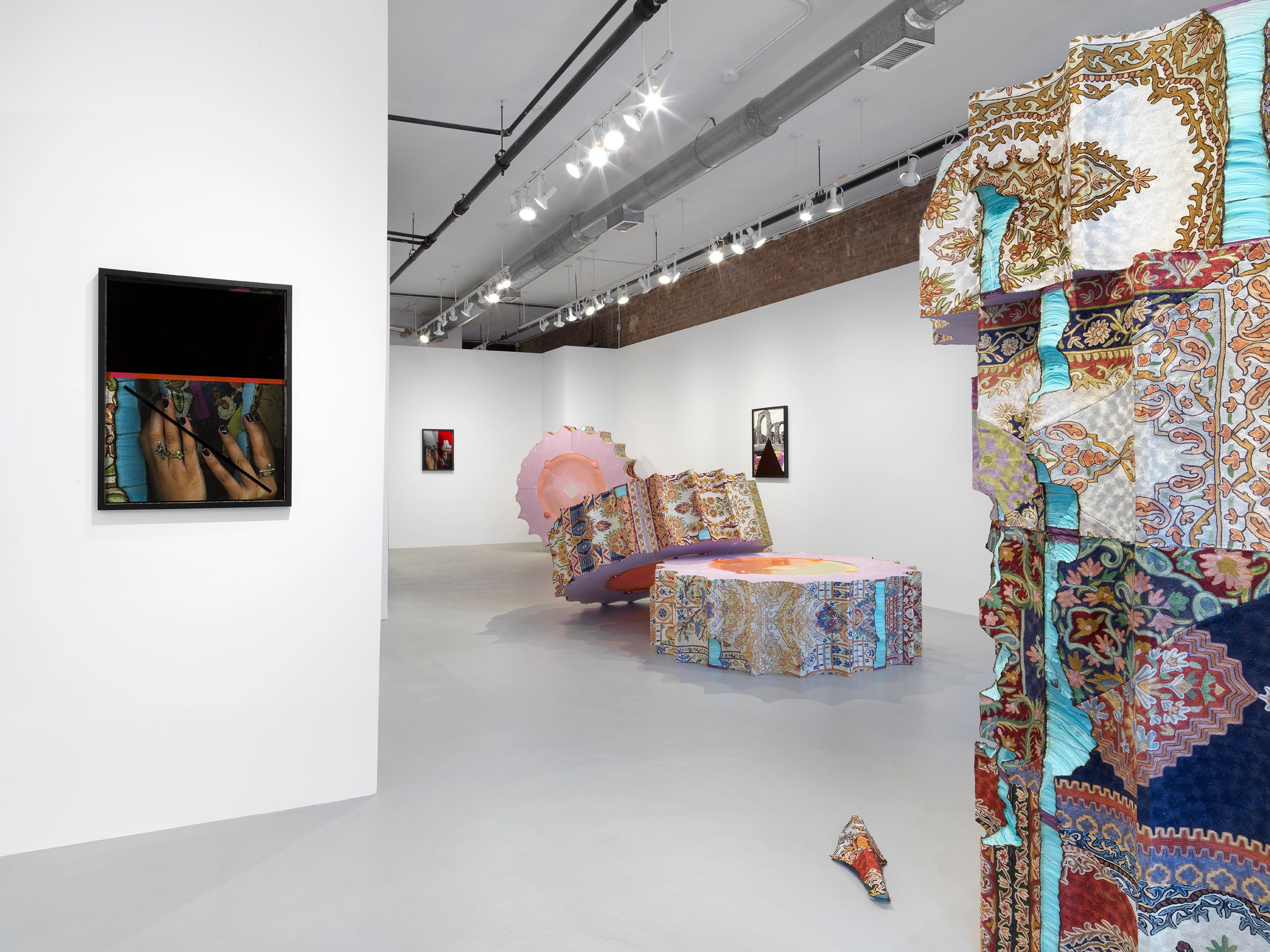“I’m showing new work about eminent fallen powers and their circumstantial influences on visual culture. I dissected a singular 6×14 foot column through material traditions of resistance and dissent, by means of collaging graphic and ornamental histories within these acts of building sovereignty. I’m unpacking the blind spots and pointing to architectural connections to our body and how we adorn and outfit ourselves.” –Baseera Khan
The years that follow Baseera Khan’s 2017 exhibition iamuslima are prolific, there is so much in between. That snake skin is about shedding feels considerable because while involuntary, it is consensual with one’s own self. Rather than forced removal, the works produced for snake skin suggest a certain grounding in the ‘underground.’ Influenced in part by German Democratic Republic Mosaik magazines obtained by Khan in Berlin in 2015 and by recent conversations about color and geometry with Kashmiri rug makers with whom she collaborates, these new pieces employ both of these elements to insinuate that seemingly benign forces are able to elicit subversive intent. This work externalizes a lesson Khan learned at a young age: self-censorship and secrecies can be aestheticized.
As Khan describes, “the Mosaik magazines were seen as unimportant by the government at the time, yet their underground following was proportionately responsible for the eventual fall of the Berlin Wall. Similarly, the Kashmiri rug makers and the traditions of radical pattern-making hold this same practice: a rug itself is banal but I like to think of its subversive possibilities and the way its underground culture can operate in the same way as Mosaik.” Much like the unforeseen timing of iamuslima, which culminated concurrently with the travel ban in 2017 [Executive Order 13769, titled Protecting the Nation from Foreign Terrorist Entry into the United States, also known as the Muslim ban], “these rugs are essentially contraband, smuggled out of Kashmir during an ongoing violent outbreak in which the Indian government is restraining movement of Kashmiri locals.”
Khan’s series of sculptural works, Column Number One – Seven, is informed in part by the columns of the Malcolm X Masjid in Harlem, which are wrapped with the same prayer rugs as the floor of the mosque, flattening the structural elements into more of an expansive landscape. The vertical columns are functional as well as emblematic of institutional power, but the rugs veil and blend them with radical ornamentation and into histories of people coming together to talk and work on these rugs together. Why adorn the column? Obfuscating its patriarchal reinforcing ideals, “the rug wraps itself like a snake choking at this system, exposing a hollow core.” In addition to wrapping, the column was subjected to various forms of performative dissection by the artist — cutting, dividing, and scraping off emancipated slivers that migrate away from the larger architectural masses. Khan’s structural disassembly and scattering of the column’s parts reveal stratified layers of foam, its ‘hollow core,’ while her surface analysis evokes the peeling flyers of postered urban spaces that distribute a collaboratively assembled collage of materials and messages.
Column Number One – Seven are paired with a series of chromatic collaged prints set in a handmade framing system with spacers made from the same Kashmiri rugs. Roman ruins, ancient mosques, and pages of Khan’s own reading material including 1980s issues of Mosaik and Arundhati Roy’s End of Imagination, are pieced together to draw connections between political revolutionary activities in Central Europe and India. Like a teenager scribbling out unwanted subjects, Khan uses Plexi cut-outs and screen-printing to redact elements of power throughout the material. Khan found the issues of Mosaik — translated for the artist by friend and scholar of German Studies, Anna Horakova — to contain “resistance and dissent from capitalist mentality, but when it came to ideas on race and religion, Mosaik seemed to be stuck in the same way the right-wing regimes were stuck. Kind of like here and now, with the failures of the left, flying toward conservative anti-Islamic, anti-immigrant, anti-black policies.” Horakova notes, “The comic was devised as a socialist educational tool that would emulate the success of Disney comics in the West, while countering their perceived capitalist bias by offering a socialist narrative. It partially succeeds in this critique, while simultaneously creating a space in which to satirize the self-legitimation of state power in East Germany and power in general, thus resonating with Khan’s own recurrent motifs of columns and carpets. At its worst, however, Mosaik evinces a recourse to racist and anti-Semitic representation in the caricatures and plot motifs it deploys – motifs that Khan’s collages appropriate and subsequently assail.”
snake skin addresses traditional representations and their misrepresentations, which have led to volatile social environments globally and most notably within capitalist-driven societies such as the U.S. Volatility creates the need for self-censorship and secrecies among people who are marginalized and othered. Deploying linguistic shifts and fashion as political mediums, Khan attempts to untrap revolutionary material through work with textiles, archives, performance, and sculpture. Revolution can often be confined by its treatment through traditional documentation and its historical archive. Creating lexicons on her own terms, Khan challenges the evidentiary capabilities of all forms of documentation. Here, Khan’s precise alterations of architecture privilege “peculiar ruins,” and unseated or fallen powers, giving the feeling that their far-reaching implications are manifested in other forms of adornment like clothing or jewelry, or that they move the culture through music, and influence “the way people feel they can occupy and speak in spaces of generative cultural shifts.” Shedding and un-shedding.
–Written by Lia Gangitano



















































































































